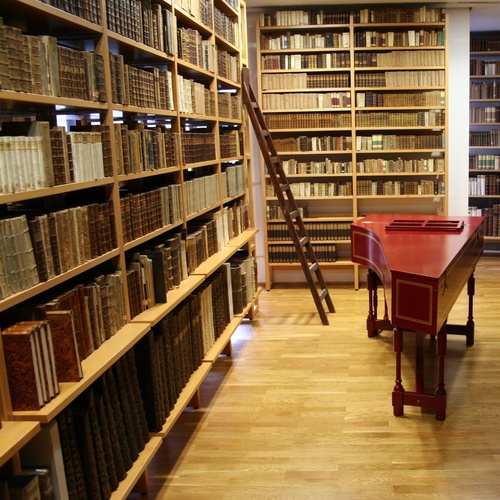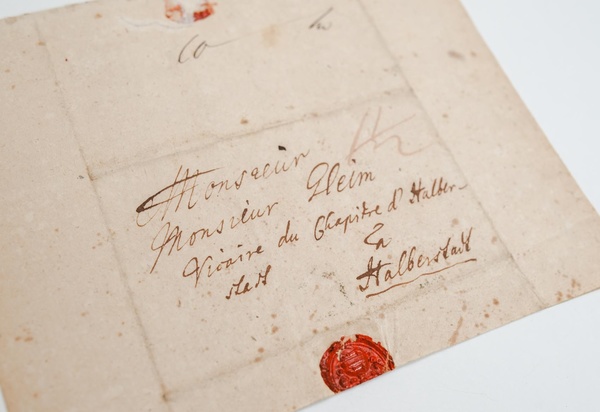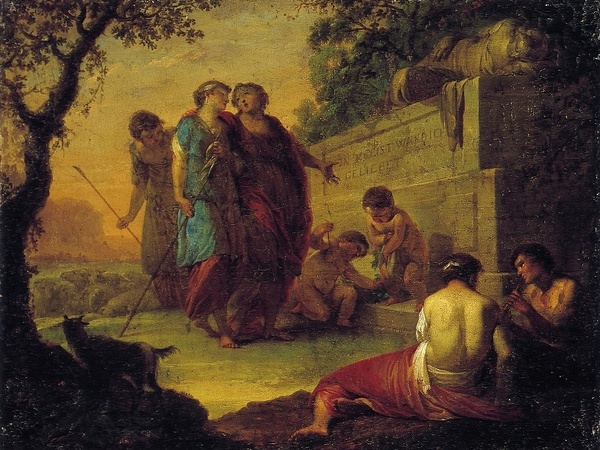
Gleim's collections reflect the literary development of Gleim's time and the culture of friendship of the Enlightenment. The Gleimhaus as a museum is not primarily defined by Gleim’s household items or even his literary works, but by his collections of Bilder (portraits), Bücher (books), and Briefe (letters)—referred to as the ‘three B’s’.
Today, it is the largest preserved 18th century poet's estate in its original conceptual arrangement in its historical location.
Large parts of the collection can be researched online.

Gleim’s estate includes one of the most significant private book collections of the 18th century, largely preserved intact at its historic location. Supplemented by a research library, the collection today comprises approximately 30,000 volumes. The library holdings of the Gleimhaus are catalogued in K10plus, the union catalogue of the libraries of ten German federal states, the Prussian Cultural Heritage Foundation and numerous other institutions in science, politics, and culture. In the OPAC (Online Public Access Catalogue) it is possible to only search the holdings of the Gleimhaus. Selected works will be successively added to the Digishelf portal.
The Gleimhaus library is a member of the Arbeitsgemeinschaft der Spezialbibliotheken e.V. (Association of Special Libraries) /Section 5 of the German Library Association.
Johann Wilhelm Ludwig Gleim was a real bibliomaniac. From a young age, he collected books—both antiquarian and modern. With its incunabula, numerous books from the 16th and 17th centuries, and vast collection of 18th-century works, the Gleim Library is one of the largest preserved bourgeois libraries of the time. The breadth of Gleim’s collecting interests makes his library valuable to research across various disciplines even today. In the modern extension of the Gleimhaus, all visitors can view Gleim’s rich book collection.
Gleim saw himself as a book collector for others as well, as evidenced by his bookplate “Gleimii et amicorum”. The books were available to 'Gleim and friends'. Many of his friends used the collection as if it were a public library. In his will, Gleim stipulated that the books should remain accessible to the public even after his death.
The library has continually expanded, with a focus on works by Gleim himself.
Access to the collection is available by appointment in the reading room.
Complementing the historical book collection, the working and research library gathers relevant scholarly editions from Gleim’s era, as well as research literature from various disciplines. The focus is on the literary, cultural, and social history of the 18th century, along with publications on Gleim and his circle of friends, including relevant editions of their correspondence. Works of art history, books on the history of paper, books and libraries as well as publications on regional history are also available, as is the extensive collection of reference works, encyclopaedias and bibliographies.
The library can be used during opening hours in the reading room and most titles can be borrowed for a period of two weeks.

As a young man, Johann Wilhelm Ludwig Gleim began amassing an extensive collection of his friends’ manuscripts, including letters, manuscript works, and other handwritten documents such as autobiographical writings, official correspondence, and more. In his later years, Gleim’s "Letter Archive" or "Muse Archive" became widely known. Anyone who wished to have something preserved sent it to Gleim. This makes it justifiable to refer to it as the first German literary archive. Thinking beyond his time, Gleim specified in his will that his manuscript collection should be made publicly available for future generations. This task continues to be carried out by the museum and researchers to this day.
The letter collection of the Gleimhaus is catalogued in K10plus, the union catalogue of libraries from ten German federal states, the Prussian Cultural Heritage Foundation, and numerous other institutions from the fields of science, politics, and culture.
Additionally, the collection is gradually being integrated into the national portal for archival records, autographs, and publishing archives, Kalliope.
In the OPAC (Online Public Access Catalogue) it is possible to only search the holdings of the Gleimhaus. In addition to the bibliographic information, the digitised letters are also displayed here, as well as in the digishelf portal.
"Each friend's letters, arranged chronologically, would make a good contribution to the history of German literature ..." (Gleim)
The most extensive collection of manuscripts are the letters, which include not only letters from Gleim's correspondence, but also letters written by friends to third parties. Almost 10,000 letters from around 500 correspondences have been preserved in the Gleimhaus. The entire collection of letters has been digitised. The collection of letters is continually being expanded through acquisitions.
Although only a small number of autobiographical writings, official letters, receipts etc. have been preserved in the Gleimhaus, they provide important information about the context of literary life in the 18th century. The files relating to Gleim's work as cathedral secretary are kept elsewhere.
Among the autobiographical texts is, for example, a manuscript by the young poet Johann Benjamin Michaelis (1746–1772), who, after falling gravely ill, was taken in by Gleim and, at Gleim’s encouragement, wrote down his life story. Also included is Gleim’s financial ledger from his time as a student.
The majority of the manuscripts collected by Gleim consists of his own literary work. He repeatedly refined his poems, never quite satisfied with them. In addition to Gleim's poetic legacy, the collection also contains many works by his friends. Their digital cataloguing is in preparation.
Gleim frequently emphasised his strong desire to collect the works of his friends. A manuscript was considered safe in Gleim's hands. Out of respect for future generations, he often confirmed the authorship of the manuscripts or explained their context. This further highlights that, alongside the letters, Gleim wished for his friends’ poetic works to also be preserved for posterity.
Several friends entrusted Gleim with their poetic legacies, such as Ewald von Kleist, Jakob Immanuel Pyra, Anna Louisa Karsch, and Johann Benjamin Michaelis. Additionally, friends like Friedrich Gottlieb Klopstock, Gotthold Ephraim Lessing, and Johann Heinrich Voß sent poems alongside their letters, which Gleim carefully preserved.

Of Gleim's extensive art collection, essentially only the portrait painting collection known as the “Temple of Friendship” has been preserved. Since the museum's founding, additional collections related to the Age of Enlightenment, portraiture, and regional art have been established.
Here, you have the opportunity to learn more about the Temple of Friendship, the graphic and art collections, as well as the artist estates.